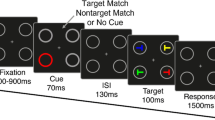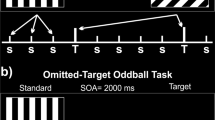Abstract
This study aimed to finding modality-independent event-related potentials (ERP) modulations related to spatial attention by minimising several possible methodological constrains which may account for the rareness of this finding in past spatial attention ERP research. ERP were recorded while subjects performed a shifting spatial attention task of either auditory, visual or mixed (both auditory and visual) modality. Task requirements and stimulation devices were identical for either modality. Stimuli could appear (80%, valid trials) or not (invalid trials) at predicted locations, and subjects had to perform a speeded response to every stimulus. Reaction time benefits were found for valid trials. Instead of the usually found enhancement of sensory-evoked modality-specific components for valid trials, ERP showed modality-independent modulations as a function of attention. They consisted of a fronto-central activity starting 240 ms after stimulus onset and originated in the anterior cingulate gyrus, followed 40 ms later by a bilateral parietal cortex activation. These processes would be reflecting the activity, respectively, of the anterior and posterior attention systems postulated in Posner's model (Posner and Petersen 1990), which showed a higher degree of participation during invalid trials. P300-like processes were also observed for invalid trials. These results demonstrate that supramodal effects of spatial attention on ERP can be obtained. Furthermore, they extend Posner's model by indicating the timings of implication of the attention subsystems.
Similar content being viewed by others
References
American Electroencephalographic Society. Guidelines for standard electrode position nomenclature. J. Clin. Neurphysiol., 1991, 3: 38–42.
Anllo-Vento, L. Shifting attention in visual space: The effects of peripheral cueing on brain corrtical potentials. Intern. J. Neurosci., 1995, 80: 353–370.
Brunswick, N., and Rippon, G. Auditory event-related potentials, dichotic listening performance and handedness as indices of lateralisation in dyslexic and normal readers. Int. J. Psychophysiol., 1994, 18: 265–275.
Corbetta, M., Miezin, F.M., Shulman, G.L., and Petersen, S.E. A PET study of visuospatial attention. J.Neurosci., 1993, 13: 1202–1226.
Donchin, E., Ritter, W., and McCallum, C. Cognitive psychophysiology: endogenous components of the ERP. In: E. Callaway, P. Tueting, and S. Koslow (Eds.), Event-Related Brain Potentials in Man. Academic Press, New York, 1978: 349–412.
Duncan-Johnson, C., and Donchin, E. On quantifying surprise: the variation of event-related potentials with subjective probability. Psychophisiology, 1977, 14: 456–467.
Eimer, M. Spatial cueing, sensory gating and selective response preparation: An ERP study on visuo-spatial orienting. Electroenceph. Clin. Neurophysiol., 1993, 88: 408–420.
Eimer, M. “Sensory gating” as a mechanism for visual-spatial orienting: Electrophysiological evidence from trial-by-trial cueing experiments. Percept. Psychophys, 1994, 55: 667–675.
Eimer, M. ERP modulations indicate the selective processing of visual stimuli as a result of transient and sustained spatial attention. Psychophysiology, 1996, 33: 13–21.
Farah, M.J., Wong, A.B., Monheit, M.A., and Morrow, L.A. Parietal lobe mechasnisms of spatial attention: Modality specific or supramodal?. Neuropsychologia, 1989, 27: 461–470.
Heinze, H.J., Mangun, G.R., Burchert, W., Hinrichs, H., Scholz, M., Münte, T.F., et al. Combined spatial and temporal imaging of brain activity during visual selective attention in humans. Nature, 1994, 372: 543–546.
Hillyard, S.A., Simpson, G.V., Woods, D.L., Van Voorhis, S., Münte, T.F. Event-related brain potentials and selective attention to different modalities. In: F. Reinoso-Suárez, C. Ajmone-Marsan, (Eds.), Cortical Integration. Raven Press, New York, 1984: 395–414.
Hillyard, S.A., Mangun, G.R., Woldorff, M.G., and Luck, S.J. Neural systems mediating selective attention. In: M.S. Gazszaniga (Ed.), The Cognitive Neurosciences. Cambridge, MA: MIT Press, 1995: 665–681.
Hjorth, B. An on-line transformation of EEG scalp potentials into orthogonal source derivations. Electroenceph. Clin. Neurophysiol., 1975, 39: 526–530.
Hjorth, B. Source derivation simplifies topographical EEG interpretation. Am. J. EEG. Technol., 1980, 20: 121–132.
Jennings, J.R., and Wood, C.C. The e-adjustment procedure for repeated-measures analyses of variance. Psychophysiology, 1976, 13: 277–278.
Johnson, R. On the neural generators of the P300 component of the event-related potential. Psychophysiology, 1993, 30: 90–97.
Knudsen, E.I., and Brainard, M.S. Creating a unified representation of visual and auditory space in the brain. Annu. Rev. Neurosci., 1995, 18: 19–43.
Mangun, G.R., and Hillyard, S.A. Modulations of sensory-evoked brain potentials indicate changes in perceptual processing during visual-spatial priming. J. Exp. Psychol.: Hum. Percept. Perform., 1991, 17: 1057–1074.
Näätänen, R. Attention and Brain Function. Erlbaum, Hillsdale, N.J., 1992.
Oken, B.S., and Chiappa, K.H. Statistical issues concerning computerized analysis of brainwave topography. Ann. Neurol., 1986, 19: 493–494.
Pernier, J., Perrin, F., and Bertrand, O. Scalp current density fields: Concept and properties. Electroenceph. Clin. Neurophysiol., 1988, 69: 385–389.
Petersen, S.E., Corbetta, M., Miezin, F.M., and Shukman, G.L. PET studies of parietal involvement in spatial attention: Comparison of different task types. Can. J. Exp. Psychol., 1994, 48: 318–338.
Picton, T.W., Lins, O.G. and Scherg, M. The recording and analysis of event-related potentials. In F. Boller, J. Grafman (Eds.), Handbook fo Neurophysiology, Vol. 10. Elsevier, Amsterdam, 1995: 3–73.
Posner, M.I., and Dehaene, S. Attentional networks. TINS 1994; 17: 75–79.
Posner, M.I., and Petersen S.E. The attention system of the human brain. Annu. Rev. Neurosci., 1990, 13: 25–42.
Posner, M.I., Inhoff, A.W., Friedrich, F.J., and Cohen, A. Isolating attentional systems: A cognitive-anatomical analysis. Psychobiology, 1987, 15: 107–121.
Posner, M.I., Petersen, S.E., Fox, P.T., and Raichle, M.E. Localization of cognitive operations in the human brain. Science, 1988, 240: 1627–1631.
Rugg, M.D., Milner, A.D., Lines, C.R., and Phalp, R. Modulation of visual event-related potentials by spatial and non-spatial visual selective attention. Neuropsychologia, 1987, 25: 85–96.
Scherg, M. Fundamentals of dipole source potential analysis. In: F. Grandori, M. Hoke, G.L. Romani (Eds.), Auditory Evoked Magnetic Fields and Potentials. Adv. Audiol., 1990, 6: 40–69.
Scherg, M. Functional imaging and localization of electromagnetic brain activity. Brain Topogr., 1992, 5: 103–111.
Scherg, M., and Berg, P. Use fo prior knowledge in brain electromagnetic source analysis. Brain Topogr., 1991, 4: 143–150.
Schröger, E. Event-related potentials to auditory stimuli following transient shifts of spatial attention in a Go/Nogo task. Biol. Psychol., 1993, 36: 183–207.
Schröger, E. Human brain potentials signs of selection by location and frequency in an auditory transien attention situation. Neursci. Lett., 1994, 173: 163–166.
Semlitsch, H.V., Anderer, P., Schuster, P., and Preelich, O. A solution for reliable and valid reduction of ocular artifacts, applied ot the P300 ERP. Psychophysiology, 1986, 23: 695–703.
Woods, D.L. The pysiological basis of selective attention: implications of event-related potential studies. In: J. Rohrbaugh, R. Parasuranam, R. Johnson (Eds.), Event-Related Brain Potentials. Basic Issues and Applications. Oxford University Press, New York, 1990: 179–209.
Woods, D.L., Alho, K., and Algazi, A. Intermodal selective attentioin. I. Effects on event-related potentials to lateralized auditory and visual stimuli. Electroenceph. Clin. Neurophysiol., 1992, 82: 341–355.
Wright, M.J., Geffen, G.M., and Geffen, L.B. Event related potentials during cover orientation of visual attention: effects of cue validity and directionality. Biol. Psychol., 1995, 41: 183–202.
Yamaguchi, S., Tsuchiya, H., and Kobayashi, S. Electroencephalographic activity associated with shifts of visuospatial attention. Brain, 1994, 117: 553–562.
Yamaguchi, S., Tsuchiya, H., and Kobayashi, S. Electrophysisologic correlates of visuo-spatial attention shift. Electroenceph. Clin. Neurophysiol., 1995, 94: 450–461.
Author information
Authors and Affiliations
Corresponding author
Rights and permissions
About this article
Cite this article
Martín-Loeches, M., Barcelö, F. & Rubia, F.J. Sources and Topography of Supramodal Effects of Spatial Attention in ERP. Brain Topogr 10, 9–22 (1997). https://doi.org/10.1023/A:1022254822290
Issue Date:
DOI: https://doi.org/10.1023/A:1022254822290




